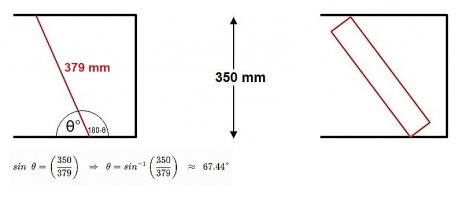Claretdcwat
New member
- Joined
- Apr 20, 2022
- Messages
- 1
Hello,
I’m sure that this is probably a really simple question but I’m struggling to remember back to my o level mathematics days!
If I have an object that measures 379mm in depth and a space of 350mm to place it on, what angle do I need to raise the object by for it to fit within the 350mm space (height no object but cannot be vertical).
Effectively, I’m wanting to fit a box in a until where the box is deeper than the unit allows.
What is the formula / calculation that I should use?
Thank you for any help.
I’m sure that this is probably a really simple question but I’m struggling to remember back to my o level mathematics days!
If I have an object that measures 379mm in depth and a space of 350mm to place it on, what angle do I need to raise the object by for it to fit within the 350mm space (height no object but cannot be vertical).
Effectively, I’m wanting to fit a box in a until where the box is deeper than the unit allows.
What is the formula / calculation that I should use?
Thank you for any help.

